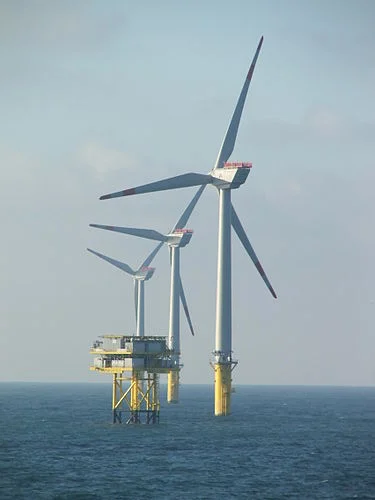
Eversource and Orsted to partner in 2 offshore wind projects
From The New England Council (newenglandcouncil.com):
Eversource and Ørsted have announced a partnership in two offshore wind projects off the coast of Massachusetts and Rhode Island. This partnership marks Eversource’s entrance into offshore wind energy.
Eversource is purchasing a 50 percent stake in two projects being developed by Ørsted — the Revolution Wind and South Fork Wind Farm. In addition to the wind projects themselves, the wind-power industry and state governments have committed to investing in the State Pier in New London, Conn., which will be used as a transit point for turbines and parts. The Revolution Wind partnership will deliver enough energy to power 420,000 homes and businesses in Rhode Island and Connecticut. The South Fork Wind Farm will provide electricity for more than 70,000 homes on eastern Long Island.
Executive Vice President of Enterprise Energy Strategy at Eversource Lee Olivier, commenting on on wind energy, said “We think it’s the future in this region. . . We think when you look at the proximity where much of offshore wind will be developed, it’s a good opportunity to bring the future into New London. It’s a real advantage for developing wind in the Northeast.”
“We are excited to have Eversource join us as we embark on the creation of the strongest U.S. offshore wind platform,” added Thomas Brostrøm, CEO of Ørsted U.S. Offshore Wind and president of Ørsted North America.
The New England Council applauds this new partnership between Eversource and Ørsted, and the impact it will have on expanding access to renewable energy in New England.
Tim Faulkner: Will hurricanes imperil wind turbines off the Northeast?
Via ecoRI.org
As new offshore wind farms are built off the Northeast coast, a new report suggests that the current models of wind turbines may not withstand the most powerful of hurricanes. The study, by the University of Colorado Boulder, the National Center for Atmospheric Research and the U.S. Department of Energy, is intended to help the budding offshore wind industry as it expands into hurricane-prone regions, such as the East Coast.
“We wanted to understand the worst-case scenario for offshore wind turbines, and for hurricanes, that’s a Category 5,” said Rochelle Worsnop, lead author and a graduate researcher in the University of Colorado's Department of Atmospheric and Oceanic Sciences (ATOC).
Current design standards require offshore wind turbines be built to withstand 112-mph winds. Using computer-generated simulations, researchers found that portions of Category 5 hurricanes can reach up to 200 mph. Turbine blades also can be stressed by sudden and powerful shifts in wind direction, called veer.
Offshore wind turbines are typically larger than land-based turbines because components can be shipped over water instead of along size-restrictive railways and roads. The structures are therefore exposed to greater harm over their 20- to 30-year life, according to the report.
“Success could mean either building turbines that can survive these extreme conditions, or by understanding the overall risk so that risks can be mitigated, perhaps with financial instruments like insurance,” said Julie Lundquist, a co-author of the study and a professor at ATOC and the Renewable and Sustainable Energy Institute.
A subsequent study by the same group will look at the long-term effects of hurricanes on offshore wind farms built off the Atlantic Coast.
Rhode Island holds the honor of building the country’s first offshore wind farm, with the completion of the Block Island Wind Farm last November. The developer of the five-turbine, 30-megawatt wind farm, Providence-based Deepwater Wind, says the University of Colorado study is more relevant to the Southeast, where hurricane are more common and more powerful.
“Current offshore wind turbine designs are suitable for the wind conditions expected in the Northeast, where the strongest hurricane to make landfall in recorded history was a Category 3," Deepwater Wind spokeswoman Meaghan Wims said.
The most recent Category 3 hurricane to make landfall in New England was Hurricane Carol on Aug. 31, 1954. The storm had a sustained wind of 110 mph.
Deepwater Wind designs its turbines to withstand a 100-year storm, which has top wind speeds of 134 mph.
In the coming the decades, the company is planning to erect wind farms in the waters between Maryland and Maine.
“We don’t expect offshore wind energy to be deployed in the Southeast in the near term for other reasons — namely, a lower offshore wind resource than the Northeast,” Wims said.
Deepwater Wind and other developers have proposed multiple projects off of the wind-rich Northeast coast. Deepwater Wind is advancing a 15-turbine project, called South Fork Wind Farm, off eastern Long Island. Its Deepwater ONE project is slated for thousands of acres of federal waters between Massachusetts and Rhode Island. Vineyard Wind and DONG Energy, both based in Denmark, are also planning projects in the region. Bay State Wind, owned by DONG and Eversource Energy, intends to build several wind farms in the region.
But it’s only a matter of time before these wind turbines are tested by hurricanes. A report by the Union of Concerned Scientists says climate change, and warming oceans in particular, are making coastal storms more intense. Since the 1970s, the number of Category 4 and 5 hurricanes has almost doubled. Category 5 hurricanes have winds exceeding 157 mph; Category 4 winds blow between 130 and 156 mph; Category 3 winds are between 111 and 129 mph.
Tim Faulkner writes for ecoRI News.



